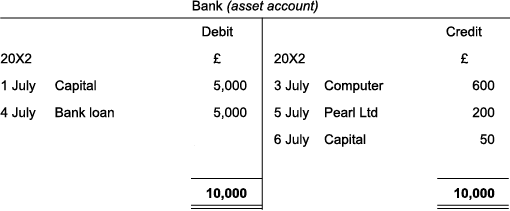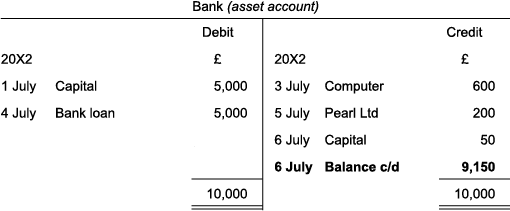4.2.1 The procedure for balancing off T-accounts
Accounts are straightforward to balance off if they consist of only one type of entry, i.e. only debit entries or only credit entries. In this case, all the account entries are simply added up to get the balance on the account. If, for instance, a bank account has three debit entries of £50 each, then the balance on the account is a debit balance of £150. However, when accounts consist of debit and credit entries, there is a procedure that should be used to balance off these accounts. Take the bank account:

The procedure for balancing it is:
- Add up the side with the highest total.

- Enter the larger figure as the total for both the debit and credit sides.
- For the side that does not add up to this total, calculate the figure that makes it add up by deducting the smaller total (600 + 200 + 50 = 850) from the larger total (10,000). Enter this figure (10,000 – 850 = 9,150) so that the total adds up, and call it the balance carried down. This is usually abbreviated as ‘Balance c/d’.
- Enter the balance brought down (abbreviated as Balance b/d) on the opposite side below the total figure. (The balance brought down is usually dated one day later than the balance carried down as one period has closed and another one has started.)

Edgar Edwards’ bank account in the general ledger has now been balanced off. The debit side was greater than the credit side, therefore leaving a debit balance of £9,150. The balance on the bank account reflects that £10,000 has come into this asset account and £850 has gone out to leave the debit balance of £9,150. This is why on the opposite side to the ‘Balance c/d’ figure, a ‘Balance b/d’ figure is needed to represent a closing debit balance.
The brought down balances at the end of the accounting period will be the opening balances of the next accounting period.
Using the rules above, all of the other accounts in Edgar Edwards’ general ledger accounts can now be balanced off.
The furniture account has a single entry on one side. This amount is the total as well as the balance in the account.

The computer and bank loan accounts have single entries on one side, like the furniture account, so they need to be treated in the same way.

In the next activity you will balance off the two accounts that we have not yet dealt with, the liability account ‘Pearl Ltd’ and the capital account. In order to do this you will need to follow the four-point procedure that was used to balance off the bank account. In this activity you will again not enter the answer in a box but will instead have an opportunity to work out the answer mentally before you click on the ‘Reveal answer’ button.
Activity 1 Balancing off a T-account where there is both a debit and a credit
Complete the entries in the following two accounts for Edgar Edwards Enterprises in order to correctly balance off the accounts:
Answer

The account for the liability, Pearl Ltd, has a debit and a credit entry so the method used above to balance the bank account can be used to balance the Pearl Ltd account and also the capital account below.

Now all the general ledger accounts have been balanced off, a trial balance can be prepared by listing all the balances (brought down balances) on Edgar Edwards’ general ledger as follows:



